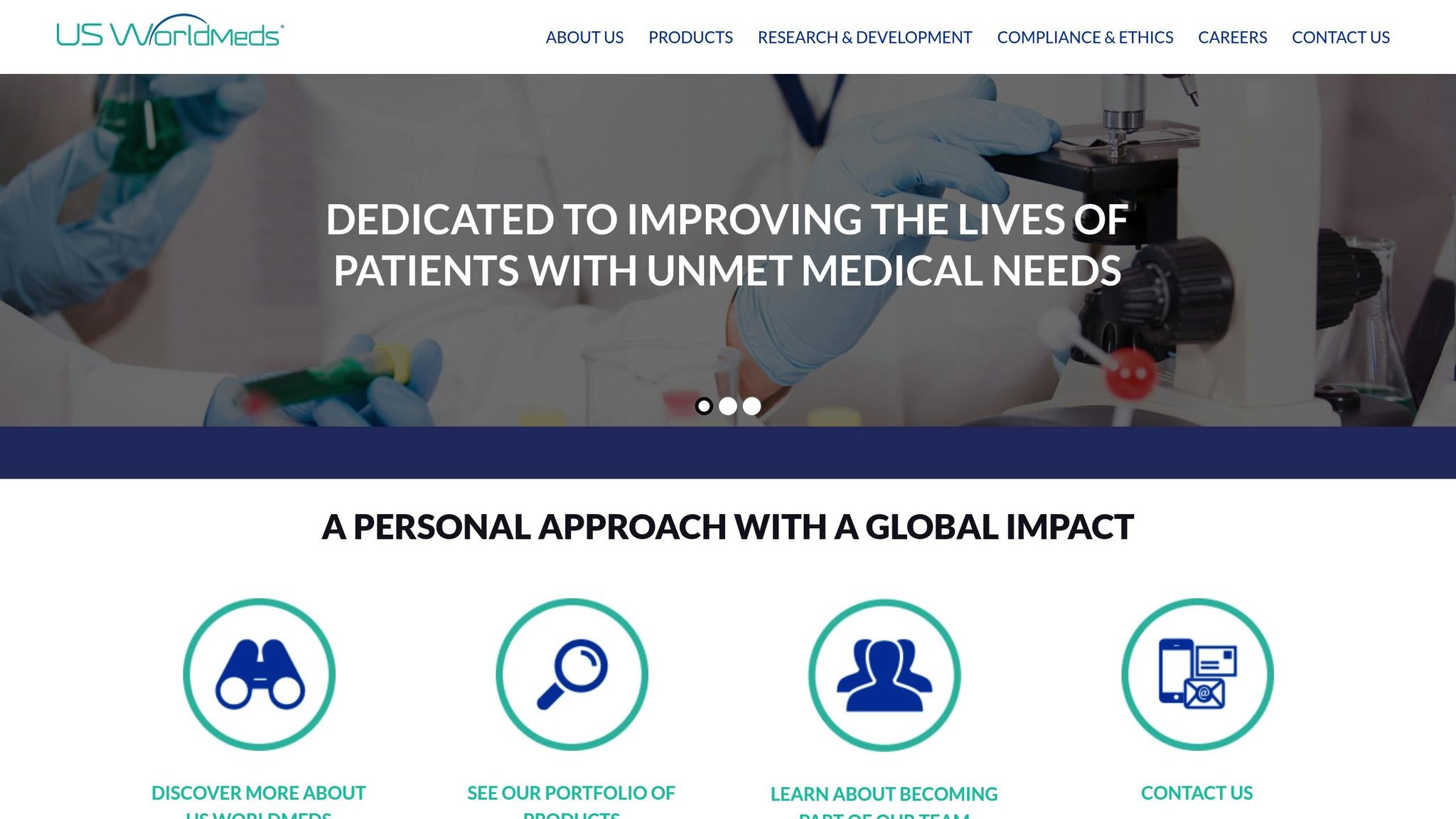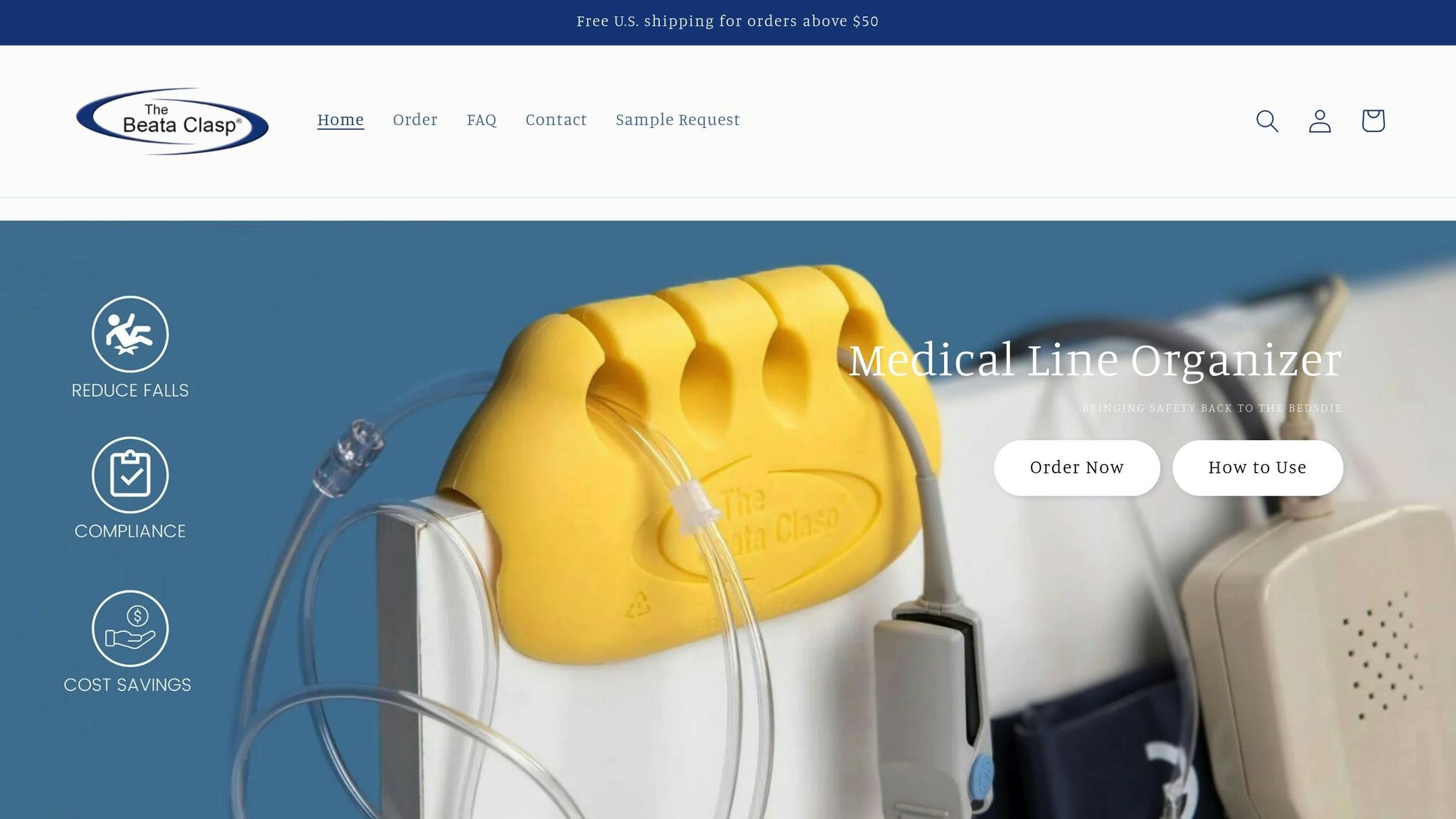Managing IV lines is a critical part of patient safety in healthcare. WorldMed’s Line Awareness Program introduces standardized protocols, training, and tools to reduce IV line errors, simplify workflows, and improve care quality. The program aligns with national safety standards and provides practical solutions like color-coded labels, line tracing protocols, and antimicrobial organizers to keep IV lines organized and safe.
Key highlights include:
- Training and Protocols: Staff are trained in best practices for IV line management, supported by clear, uniform guidelines.
- Tools for Safety: Products like the Beata Clasp help prevent line tangling, disconnections, and contamination risks.
- Implementation Steps: A phased rollout approach ensures smooth adoption, guided by nurse champions and ongoing evaluations.
Preventing IV Line Contamination
What is WorldMed's Line Awareness Program

WorldMed's Line Awareness Program addresses the challenges associated with IV lines in U.S. healthcare settings. By introducing standardized protocols and comprehensive training, the program aims to improve patient safety and reduce errors tied to IV line management. Below, we’ll explore its objectives, key components, and how it aligns with national safety guidelines.
Main Goals of the Program
The primary goals of the program are to decrease IV line-related errors, simplify nursing workflows, and cultivate a culture of safety. This is achieved by implementing consistent procedures and providing thorough staff education.
Program Components
The program is built around several essential elements:
- Staff Training: Focused sessions on IV line best practices equip healthcare workers with the knowledge and skills to handle lines effectively.
- Standardized Protocols: Clear, uniform guidelines are established to organize and identify IV lines, reducing the risk of confusion during care.
- Organizational Tools: Practical tools are introduced to streamline IV line management, ensuring smoother operations.
- Regular Safety Assessments: Continuous evaluations allow healthcare teams to identify areas for improvement and maintain high safety standards.
Meeting National Safety Standards
WorldMed's program is closely aligned with national safety priorities, adhering to guidelines set by the FDA and The Joint Commission. These standards emphasize the importance of standardized procedures and empowering staff to minimize errors. By adopting best practices and conducting ongoing evaluations, the Line Awareness Program helps healthcare facilities achieve critical patient safety objectives.
Strategies and Tools for IV Line Organization
Keeping IV lines organized is a critical part of creating safer bedside environments. By combining practical strategies with specialized tools, healthcare teams can reduce errors, enhance patient safety, and streamline care. Building on WorldMed's standardized protocols, these methods are designed to improve outcomes and simplify daily workflows.
Effective Line Management Strategies
-
Color-Coded Labeling Systems
Assigning distinct colors to IV lines based on medication type allows nurses to quickly identify the correct line, especially during emergencies. This simple visual system can significantly reduce the chance of errors. -
Line Tracing Protocols
Tracing each IV line from the patient’s access point to the infusion pump before administering medication ensures the correct drug is delivered via the proper route. This hands-on approach minimizes mistakes and reinforces safety. -
Bedside Checklists
Checklists at the bedside help nurses verify critical details, such as patient identity and line patency, before connecting or administering IV medications. These checklists also include compatibility checks to prevent errors during hectic shifts. -
Positioning Strategies
Properly organizing IV lines to avoid crossing or tangling improves visibility and reduces the risk of accidental disconnections. This approach also makes bedside care smoother and safer, even when patients move.
Tools Designed for Bedside Safety
-
Antimicrobial Line Organizers
These organizers keep IV lines separated while incorporating antimicrobial properties to lower infection risks. They’re especially useful in settings where infection control is a top priority. -
High-Visibility Attachments
Brightly colored or reflective attachments make IV lines easier to spot, even in dim lighting. This added visibility helps prevent accidental tugging or disconnections by ensuring that lines are clearly noticeable to everyone around the patient. -
Securing Devices
Designed to prevent IV lines from falling or tangling with bed rails or equipment, securing devices often use mechanical attachments instead of adhesives. This avoids issues like skin irritation or sticky residue while keeping lines securely in place. -
Line Identification Tags
Paired with color-coding, these tags display key details about the IV line - such as medication type, concentration, and infusion rate. They’re especially helpful in low-light conditions, adding another layer of safety for patients.
Comparing IV Line Management Tools
| Tool Type | Primary Benefits | Key Limitations | Best Use Cases |
|---|---|---|---|
| Adhesive Organizers | Affordable and easy to apply | May cause skin irritation or leave residue | Short-term use, stable patients |
| Magnetic Attachments | Reusable and avoids skin contact | Requires metal surfaces; may interfere with equipment | ICU settings with metal bed frames |
| Clip-Based Systems | Versatile and adhesive-free | Can slip with patient movement | General medical units, ambulatory care |
| Antimicrobial Organizers | Combines infection control with durability | Higher upfront cost | High-risk patients, long-term use |
The choice of tools depends on patient needs, unit requirements, and budgets. While antimicrobial organizers may have a higher initial cost, they provide added infection control benefits, making them a worthwhile investment for high-risk or long-term cases. Reusable tools that can be cleaned and sterilized also offer long-term value. Many facilities opt for a mix of tools to adapt to different clinical situations, ensuring both efficiency and safety. These comparisons pave the way for practical implementation strategies and a deeper dive into product benefits in the next section.
sbb-itb-f779e18
How to Implement the Program: Practical Applications and Nurse-Led Solutions
Bringing WorldMed's Line Awareness Program into practice requires a structured approach that equips nurses with the tools, knowledge, and accountability they need to succeed. Here’s a practical guide to get started.
Step‑by‑Step Implementation Guide
1. Secure Leadership Support and Identify Nurse Champions
Start by gaining buy-in from leadership and appointing nurse champions - experienced staff members who can provide guidance and resolve issues during the transition.
2. Educate Staff
Organize training sessions focused on the program's core principles, safety protocols, and hands-on practice with IV tools. To maximize participation, schedule these sessions during shift overlaps and offer make-up classes for those who miss the initial training.
3. Roll Out Standardized Protocols Gradually
Introduce the new protocols one unit at a time. This phased approach allows for real-time feedback, helping you identify and address challenges early on. Use brief team meetings or huddles to discuss obstacles and celebrate initial successes.
4. Maintain and Refine the Program
Keep the program on track with regular competency assessments, audits, and reviews. Use data from near-miss incidents and safety events to fine-tune processes. Adjust the timeline as needed based on your facility’s size, ensuring clear communication and proper resource distribution throughout the rollout.
Improving Safety with Beata Clasp: A Key Tool in IV Line Management

The Beata Clasp is a practical addition to WorldMed's Line Awareness Program, designed to reduce IV line errors. This soft, recyclable foam clasp was created by nurses who understand the bedside challenges of managing multiple IV lines, drains, and tubing.
Beata Clasp Features and Benefits
The Beata Clasp directly addresses safety concerns by securely holding medical lines in circular grooves and attaching to hospital bedrails. This simple yet effective design keeps tubing organized, preventing the chaos of tangles and misplaced lines.
One of its standout features is its ability to keep lines off the floor, reducing contamination risks and minimizing trip hazards for both patients and staff. The clasp's antimicrobial properties add another layer of protection against infection.
By eliminating the need for makeshift solutions, the Beata Clasp saves nurses time and reduces the frustration of untangling or repositioning tubing. It’s easy to implement, requiring no extra training, which makes it a seamless addition to busy nursing workflows.
The design prioritizes safety and practicality. It’s latex-free, doesn’t block IV tubing, and comes in a high-visibility yellow color, making it easy to locate during patient care. Its 4-hole design accommodates multiple lines, ensuring everything stays organized even when patients are moved.
Additionally, the Beata Clasp supports eco-conscious practices. Made from recyclable foam, it can be reused for single patients or disposed of based on facility protocols. This thoughtful design aligns with hospital sustainability goals while offering flexibility in use.
Pricing Options for U.S. Healthcare Settings
The Beata Clasp is available in various pricing options to meet the needs of different healthcare facilities:
| Option | Price | Best For | Key Benefits |
|---|---|---|---|
| Individual Unit | $19.95 per unit | Small clinics, home care | Affordable for limited use |
| Evaluation Pack | $163.00 (10 units) | Pilot programs, unit testing | Ideal for trial implementation |
| Bulk Order | $467.50 (25 units) | Hospitals, large facilities | Cost-effective for widespread use |
The Individual Unit option at $19.95 is ideal for smaller settings or home care scenarios where only a few devices are needed. The Evaluation Pack is perfect for facilities wanting to test the Beata Clasp across different units before committing to a larger purchase. For hospitals adopting the Line Awareness Program on a larger scale, the Bulk Order provides the best value per unit, ensuring an adequate supply for multiple departments.
Building a Culture of Safety with Beata Clasp
Beyond its operational advantages, the Beata Clasp strengthens the Line Awareness Program’s focus on nurse-driven solutions and patient trust. By addressing real challenges faced by frontline staff, this tool demonstrates a commitment to improving both safety and workflow efficiency.
When facilities invest in tools like the Beata Clasp, it sends a clear message to nurses: their work environment and concerns matter. This often leads to higher staff satisfaction, as the clasp reduces the daily frustrations of managing tangled lines and allows nurses to dedicate more time to patient care.
The benefits extend to patients as well. An organized and elevated IV line system not only improves safety but also boosts patient confidence. When patients and their families see that medical equipment is well-managed, it reinforces their trust in the quality of care they’re receiving. This attention to detail can positively impact patient satisfaction scores and overall perceptions of care quality.
Conclusion: Moving Forward with Better IV Line Management
Improving IV line management can transform bedside safety in healthcare settings. When hospitals and clinics prioritize practical tools and nurse-led innovations, they can address everyday challenges more effectively.
Keeping IV lines secure, elevated, and well-organized allows healthcare professionals to focus on what matters most - delivering quality care. This methodical approach minimizes medical errors, lowers infection risks, and fosters a safer environment for both patients and staff.
Tools like the Beata Clasp offer practical, immediate solutions. By simplifying IV line organization, such tools enhance safety without requiring extensive training or disrupting existing workflows. They demonstrate how simple changes can lead to meaningful improvements.
Investing in reliable IV line management systems benefits everyone. It reduces complications, boosts staff morale, and reassures patients. Solutions designed by nurses - who truly understand the realities of bedside care - bring practical, impactful improvements to clinical environments.
FAQs
How does WorldMed’s Line Awareness Program enhance patient safety and improve IV line management?
WorldMed’s Line Awareness Program is designed to boost patient safety by tackling common issues in managing and organizing IV lines. The program offers tools and strategies aimed at minimizing errors like mismanaged lines or accidental disconnections, which could result in serious complications.
By simplifying workflows and focusing on nurse-led solutions, the program enhances visibility and control over IV lines. This not only reduces risks but also improves the overall quality of care. With practical methods tailored for real-world use, it equips healthcare providers to deliver safer and more efficient bedside care.
What training and tools does the Line Awareness Program offer to help prevent IV line errors?
The Line Awareness Program offers targeted training and practical tools aimed at reducing IV line-related mistakes and improving patient safety. This initiative provides hands-on education for nurses and healthcare workers, emphasizing proper techniques for organizing, maintaining, and troubleshooting IV lines.
The program's resources include color-coded line labels, simplified workflows for handling multiple lines, and visual aids to help prevent line mix-ups. These tools are designed to boost efficiency, lower the risk of complications, and create a safer environment for both patients and caregivers at the bedside.
How does the Beata Clasp improve bedside safety and help prevent IV line errors?
The Beata Clasp is a smart tool designed to boost bedside safety by keeping IV lines neatly organized. It helps cut down on tangles and confusion, reducing the chances of errors like delivering the wrong medication or accidental disconnections.
Beyond enhancing patient safety, it also streamlines the workflow for healthcare professionals. Since it’s designed with input from nurses, it directly addresses the practical challenges care teams face, making treatments safer and more efficient to administer.
